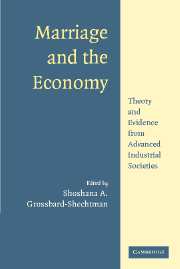Book contents
- Frontmatter
- Contents
- List of Figures
- List of Tables
- List of Contributors
- Foreword
- Acknowledgments
- Marriage and the Economy
- 1 Marriage and the Economy
- PART I THE ECONOMICS OF MARRIAGE AND DIVORCE
- PART II EFFECTS OF MARRIAGE ON INCOME USES
- PART III EFFECTS OF MARRIAGE ON TIME USES
- 9 Marriage, Household Production, and Earnings
- 10 Marriage and Work for Pay
- 11 Marriage, Work for Pay, and Childcare
- 12 Marriage and Home-Based Paid Employment
- PART IV MARRIAGE AND THE MACROECONOMY
- Index
10 - Marriage and Work for Pay
Published online by Cambridge University Press: 07 December 2009
- Frontmatter
- Contents
- List of Figures
- List of Tables
- List of Contributors
- Foreword
- Acknowledgments
- Marriage and the Economy
- 1 Marriage and the Economy
- PART I THE ECONOMICS OF MARRIAGE AND DIVORCE
- PART II EFFECTS OF MARRIAGE ON INCOME USES
- PART III EFFECTS OF MARRIAGE ON TIME USES
- 9 Marriage, Household Production, and Earnings
- 10 Marriage and Work for Pay
- 11 Marriage, Work for Pay, and Childcare
- 12 Marriage and Home-Based Paid Employment
- PART IV MARRIAGE AND THE MACROECONOMY
- Index
Summary
This chapter reports some differences between married and unmarried people – marital differentials – with respect to the following characteristics of paid employment: labor force participation, labor force attachment, and wages. Most of the evidence that we report is for the United States, although we also report patterns for some other parts of the world. We also explore some ethnic variations in marital differentials, and some changes over time.
Observed relationships between paid employment and marriage may have three possible causes: Marriage may affect labor market experience, labor market experience may affect marriage, or the relationship between marriage and labor market experience may be explained by third factors influencing both marriage and paid employment. Any explanation of marital differentials in paid employment has to start by recognizing these two facts: Marriage is an institution that organizes household production, and work in household production is a major alternative to paid employment.
Gender differences in labor supply and earnings have been well documented, and we look at women and men separately. These gender differences could be related to gender differences in household production (see Chapter 9 by Joni Hersch). At least since Jacob Mincer (1962), it has been postulated that for women household production and paid employment are inversely related.
We then present econometric models that attempt to disentangle causal relationships. We also present marriage market models that lead to the inclusion of marriage-related variables that are usually overlooked in labor supply models, including a number of individual characteristics (such as age, ethnicity, and religion) and aggregate characteristics (such as sex ratios and government policies) that are expected to affect opportunities in marriage and labor markets.
- Type
- Chapter
- Information
- Marriage and the EconomyTheory and Evidence from Advanced Industrial Societies, pp. 222 - 247Publisher: Cambridge University PressPrint publication year: 2003
- 12
- Cited by



